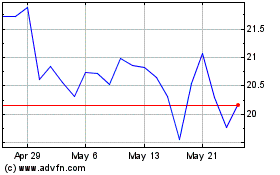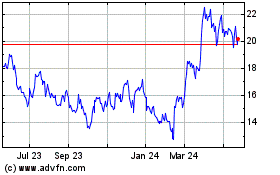Seabridge Gold (TSX:SEA) (NYSE:SA) today announced that results
from the first two core holes drilled this year into the Deep Kerr
deposit are, as planned, likely to allow for an increase in the
potential mining rate from the proposed block cave shapes designed
to exploit the deposit cost-effectively from underground. The new
holes are expected to expand the known resource to the south,
confirming grades consistent with the deposit’s inferred resource,
in the shape and orientation required to optimize the proposed mine
plan at a higher throughput.
The Deep Kerr deposit, located on Seabridge’s
100%-owned KSM Project in northwestern British Columbia, contains
an inferred resource of 1.01 billion tonnes grading 0.53% copper
and 0.35 g/T gold (11.3 million ounces of gold and 11.8 billion
pounds of copper). In the three years since its discovery, Deep
Kerr has taken its place among the world’s largest undeveloped
gold-copper deposits.
The first two holes drilled this year have
confirmed continuity of mineralization in Deep Kerr over
considerable distances south of the existing resource. K-16-51,
located about 125 meters south of the current resource limits,
intersected multiple zones including 119 meters averaging 0.44 g/T
gold and 0.45% copper and an additional 187 meters averaging 0.33
g/T gold and 0.46% copper. K-16-52 intercepted 231 meters grading
0.31 g/T gold and 0.47% copper about 500 meters laterally to the
south of K-16-51. K-16-51 and K-16-52 both intersected the
mineralized zone about 150-250 meters below the existing resource.
(See link to plan map and cross-sections.)
Seabridge Chairman and CEO Rudi Fronk commented
that “this year’s drill program has been carefully designed to
expand and optimize the prospective mine plan at Deep Kerr and
thereby improve the KSM project’s potential economics. The
mineralized intervals in these first two holes are effectively
orientated for efficient extraction. The drill results should also
contribute another meaningful increase to the Deep Kerr inferred
resource. Overall, Deep Kerr is once again demonstrating that it
has very few equals for size and grade.”
K-16-51 and K-16-52 have been re-entered for
so-called daughter holes which use the upper part of the original
hole before being wedged into new intercepts of the target zone.
The daughter holes are targeted to fill in the gaps along strike
from the original drill holes.
Over the past three years, Seabridge’s
exploration programs have successfully targeted higher grade zones
beneath KSM’s near-surface porphyry deposits, resulting in the
discovery of Deep Kerr and the Iron Cap Lower Zone, two copper-rich
deposits that have added more than one billion tonnes of inferred
resources to the project at a higher average grade.
The following table summarizes the drill hole intersections for
K-16-51 and K-16-52.
|
Drill HoleID |
TotalDepth |
From(meters) |
To (meters) |
Interval (meters) |
Gold (g/T) |
Copper % |
Silver(g/T) |
| K-16-51 |
1521.6
(*) |
928.6 |
1047.7 |
119.1 |
0.44 |
0.45 |
2.6 |
|
|
1067.7 |
1090.2 |
22.5 |
0.51 |
0.49 |
4.1 |
|
|
1137.8 |
1174.7 |
36.9 |
0.51 |
0.43 |
1.2 |
|
|
1291.4 |
1478.6 |
187.2 |
0.33 |
0.46 |
2.0 |
|
including |
1292.9 |
1337.4 |
44.5 |
0.46 |
0.67 |
1.1 |
| K-16-52 |
1834.0 |
1192.3 |
1423.5 |
231.2 |
0.31 |
0.47 |
1.8 |
|
including |
1266.5 |
1314.3 |
47.8 |
0.63 |
0.50 |
2.6 |
|
including |
1360.2 |
1421.9 |
61.7 |
0.26 |
0.78 |
2.0 |
(*) NOTE: There was no core recovery from 1047.7 to 1067.7
meters due to technical difficulties encountered during
drilling.
Drill holes were oriented using historical
information and were designed to intercept the mineralized target
at right angles to the strike of the zone. The orientation will be
refined with additional drilling but current information indicates
the intervals listed above approximate the true thickness of the
mineralized zones.
Exploration activities by Seabridge at the KSM
Project are conducted under the supervision of William E.
Threlkeld, Registered Professional Geologist, Senior Vice President
of the Company and a Qualified Person as defined by National
Instrument 43-101. Mr. Threlkeld has reviewed and approved this
news release. An ongoing and rigorous quality control/quality
assurance protocol is employed in all Seabridge drilling campaigns.
This program includes blank and reference standards, and in
addition all copper assays that exceed 0.25% Cu are re-analyzed
using ore grade analytical techniques. Cross-check analyses are
conducted at a second external laboratory on at least 10% of the
drill samples. Samples are assayed at ALS Chemex Laboratory,
Vancouver, B.C., using fire assay atomic adsorption methods for
gold and ICP methods for other elements.
Seabridge holds a 100% interest in several North
American gold projects. The Company’s principal assets are the KSM
Project and Iskut Project located near Stewart, British Columbia,
Canada and the Courageous Lake gold project located in Canada’s
Northwest Territories. For a full breakdown of Seabridge’s mineral
reserves and mineral resources by category please visit the
Company’s website at
http://www.seabridgegold.net/resources.php.
All reserve and resource estimates
reported by the Corporation were calculated in accordance with the
Canadian National Instrument 43-101 and the Canadian Institute of
Mining and Metallurgy Classification system. These standards differ
significantly from the requirements of the U.S. Securities and
Exchange Commission. Mineral resources which are not mineral
reserves do not have demonstrated economic viability.
This document contains "forward-looking
information" within the meaning of Canadian securities legislation
and "forward-looking statements" within the meaning of the United
States Private Securities Litigation Reform Act of 1995. This
information and these statements, referred to herein as
"forward-looking statements" are made as of the date of this
document. Forward-looking statements relate to future events or
future performance and reflect current estimates, predictions,
expectations or beliefs regarding future events and include, but
are not limited to, statements with respect to: (i) the expected
expansion of the Deep Kerr inferred resource to the south in the
shape and orientation required to optimize throughput at a higher
rate; (ii) the expected confirmation of the consistency of the
grade of the new mineralization with the existing resource;; (iii)
the potential expansion of the Deep Kerr resource allowing an
expansion of the potential mining rate at Deep Kerr; (iv) that the
potential expansion and optimization will improve Project
economics; and (v) the estimated amount and grade of mineral
resources. Any statements that express or involve discussions with
respect to predictions, expectations, beliefs, plans, projections,
objectives or future events or performance (often, but not always,
using words or phrases such as "expects", "anticipates", "plans",
"projects", "estimates", "envisages", "assumes", "intends",
"strategy", "goals", "objectives" or variations thereof or stating
that certain actions, events or results "may", "could", "would",
"might" or "will" be taken, occur or be achieved, or the negative
of any of these terms and similar expressions) are not statements
of historical fact and may be forward-looking
statements.
All forward-looking statements are based
on Seabridge's or its consultants' current beliefs as well as
various assumptions made by them and information currently
available to them. The principle assumptions are listed above, but
others include: (i) the block cave shapes in the Deep Kerr resource
being limited by drill data, not geology; (ii) the presence of and
continuity of metals at the Project between drill holes, including
at modeled grades; (ii) the capacities of various machinery and
equipment; (iii) the availability of personnel, machinery and
equipment at estimated prices; (iv) exchange rates; (v) metals
sales prices; (vi) block net smelter return values; (vii)
conceptual cave footprints, draw points and heights; (viii)
appropriate discount rates; (ix) tax rates and royalty rates
applicable to the proposed mining operation; (x) financing
structure and costs; (xi) anticipated mining losses and dilution;
(xii) metallurgical performance; (xiii) reasonable contingency
requirements; (xiv) success in realizing proposed operations; (xv)
receipt of regulatory approvals on acceptable terms; and (xvi) the
negotiation of satisfactory terms with impacted Treaty and First
Nations groups. Although management considers these assumptions to
be reasonable based on information currently available to it, they
may prove to be incorrect. Many forward-looking statements are made
assuming the correctness of other forward looking statements, such
as statements of net present value and internal rates of return,
which are based on most of the other forward-looking statements and
assumptions herein. The cost information is also prepared using
current values, but the time for incurring the costs will be in the
future and it is assumed costs will remain stable over the relevant
period.
By their very nature, forward-looking
statements involve inherent risks and uncertainties, both general
and specific, and risks exist that estimates, forecasts,
projections and other forward-looking statements will not be
achieved or that assumptions do not reflect future experience. We
caution readers not to place undue reliance on these
forward-looking statements as a number of important factors could
cause the actual outcomes to differ materially from the beliefs,
plans, objectives, expectations, anticipations, estimates
assumptions and intentions expressed in such forward-looking
statements. These risk factors may be generally stated as the risk
that the assumptions and estimates expressed above do not occur,
but specifically include, without limitation: risks relating to
variations in the mineral content within the material identified as
mineral reserves or mineral resources from that predicted;
variations in rates of recovery and extraction; developments in
world metals markets; risks relating to fluctuations in the
Canadian dollar relative to the US dollar; increases in the
estimated capital and operating costs or unanticipated costs;
difficulties attracting the necessary work force; increases in
financing costs or adverse changes to the terms of available
financing, if any; tax rates or royalties being greater than
assumed; changes in development or mining plans due to changes in
logistical, technical or other factors; changes in project
parameters as plans continue to be refined; risks relating to
receipt of regulatory approvals or settlement of an agreement with
impacted First Nations groups; the effects of competition in the
markets in which Seabridge operates; operational and infrastructure
risks and the additional risks described in Seabridge's Annual
Information Form filed with SEDAR in Canada (available at
www.sedar.com) for the year ended December 31, 2014 and in the
Corporation's Annual Report Form 40-F filed with the U.S.
Securities and Exchange Commission on EDGAR (available at
www.sec.gov/edgar.shtml). Seabridge cautions that the foregoing
list of factors that may affect future results is not
exhaustive.
When relying on our forward-looking
statements to make decisions with respect to Seabridge, investors
and others should carefully consider the foregoing factors and
other uncertainties and potential events. Seabridge does not
undertake to update any forward-looking statement, whether written
or oral, that may be made from time to time by Seabridge or on our
behalf, except as required by law.
ON BEHALF OF THE BOARD"Rudi Fronk" Chairman
& C.E.O.
For further information please contact:Rudi P. Fronk, Chairman
and C.E.O.Tel: (416) 367-9292 Fax: (416)
367-2711Email: info@seabridgegold.net
Seabridge Gold (TSX:SEA)
Historical Stock Chart
From Dec 2024 to Jan 2025

Seabridge Gold (TSX:SEA)
Historical Stock Chart
From Jan 2024 to Jan 2025
